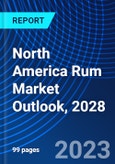This report comes with 10% free customization, enabling you to add data that meets your specific business needs.
1h Free Analyst TimeSpeak directly to the analyst to clarify any post sales queries you may have.
According to the research report, North America Rum Market Outlook, 2028 the market was valued at USD 5.63 Billion market size in 2022. The most popular kind of rum consumed in North America is usually light or white rum. Light rum frequently appears in mixed beverages and cocktails because of its moderate flavor profile. Additionally, it is well-liked for producing traditional rum-based drinks like mojitos and daiquiris. The favored type of rum can, however, differ among people and geographical areas in North America due to the recent popularity of various rum flavors and styles. In North America, conventional rum is generally more commonly used than organic rum. Conventional rum refers to rum that is produced using traditional methods and ingredients, which may include non-organic sugarcane or molasses. It is the standard type of rum available in most liquor stores and bars. Standard rum and over proof rum are often more widely used in the North American rum market. Standard rum is rum with average alcohol content (ABV) of between 35% and 40%, which is the common strength for the majority of rum brands. It is widely accessible and frequently used in a variety of mixed drinks and cocktails. In contrast, over proof rum has a greater alcohol concentration, often between 50% and 75% ABV or even higher. Bacardi, Captain Morgan, Mount Gay, Havana Club, Don Q, Appleton Estate, Cruzan, Malibu are some famous brands in North America.
Rum is now widely used in both traditional and modern cocktails on the North American continent. To make distinctive and intriguing drinks, bartenders frequently experiment with various rum kinds, infusions, and flavors. Rum's popularity stems from the variety of cocktails that may be made with it thanks to its adaptability. Government policies in North America regarding the rum market encompass a range of regulations and considerations. These policies are designed to ensure the responsible production, distribution, and consumption of rum while safeguarding public health and safety. One significant aspect of government policy is the regulation and licensing of rum production and sale. Governments impose requirements for labeling, health and safety standards, production processes, and age restrictions. These measures help maintain product quality and protect consumers from potential harm. In addition, alcohol control boards and commissions oversee the regulation and control of alcoholic beverages, including rum. They issue licenses, set pricing policies, regulate advertising and promotions, and enforce compliance with alcohol laws and regulations.
Standard or mass-market rum is typically utilised more frequently than premium rum in the North American rum market. The more extensively distributed and reasonably priced rums that are sold in supermarkets and liquor stores are referred to as mass-market rums. Usually made in bigger volumes, these rums are intended for a wide range of consumers. Premium rum, on the other hand, only makes up a minor portion of the market. Since they frequently use better-quality ingredients and go through longer ageing periods, premium rums have a higher price tag. The target market for them is often enthusiasts and aficionados who value the complexity and depth of flavors found in aged and premium rums. Liquor Stores, Supermarkets/Hypermarkets Bars, Restaurants are more preferred in distribution channels.
The United States (US) holds a more significant position in the North American rum market due to several key factors. Firstly, the US boasts a substantial consumer market with a population exceeding 330 million individuals. This large market size provides ample opportunities for rum producers to tap into a wide customer base and generate significant sales volume. Secondly, the US possesses a robust and resilient economy, making it one of the world's largest. The strength of the US economy translates into higher purchasing power and disposable income for consumers, enabling increased spending on alcoholic beverages, including rum. As a result, the US market presents an attractive proposition for rum producers seeking to capitalize on consumer demand. The US serves as a critical hub for rum importation and distribution in the North American region. Many international rum brands establish a robust presence in the US market, leveraging its extensive distribution network to reach consumers across North America. This distribution prowess enhances the availability and accessibility of rum in other North American countries.
Considered in this report
- Geography: North America
- Historic year: 2017
- Base year: 2022
- Estimated year: 2023
- Forecast year: 2028
Aspects covered in this report
- North America Rum market with its value and forecast along with its segments
- Country-wise Rum Market analysis
- Various drivers and challenges
- On-going trends and developments
- Top profiled companies
- Strategic recommendation
Countries covered in the report:
- United States
- Canada
- Mexico
Aspects covered in this report
- United States Rum Market with its value and forecast along with its segments
- Various drivers and challenges
- On-going trends and developments
- Top profiled companies
- Strategic recommendation
By Types Rum
- White Rum
- Light or Gold Rum
- Dark Rum
- Spiced and Flavored
By Nature
- Conventional
- Organic
By Category
- Standard
- Over proof
By Segment
- Mass
- Premium /Craft Rum
By Distribution Channel
- On -Trade
- Off-Trade








